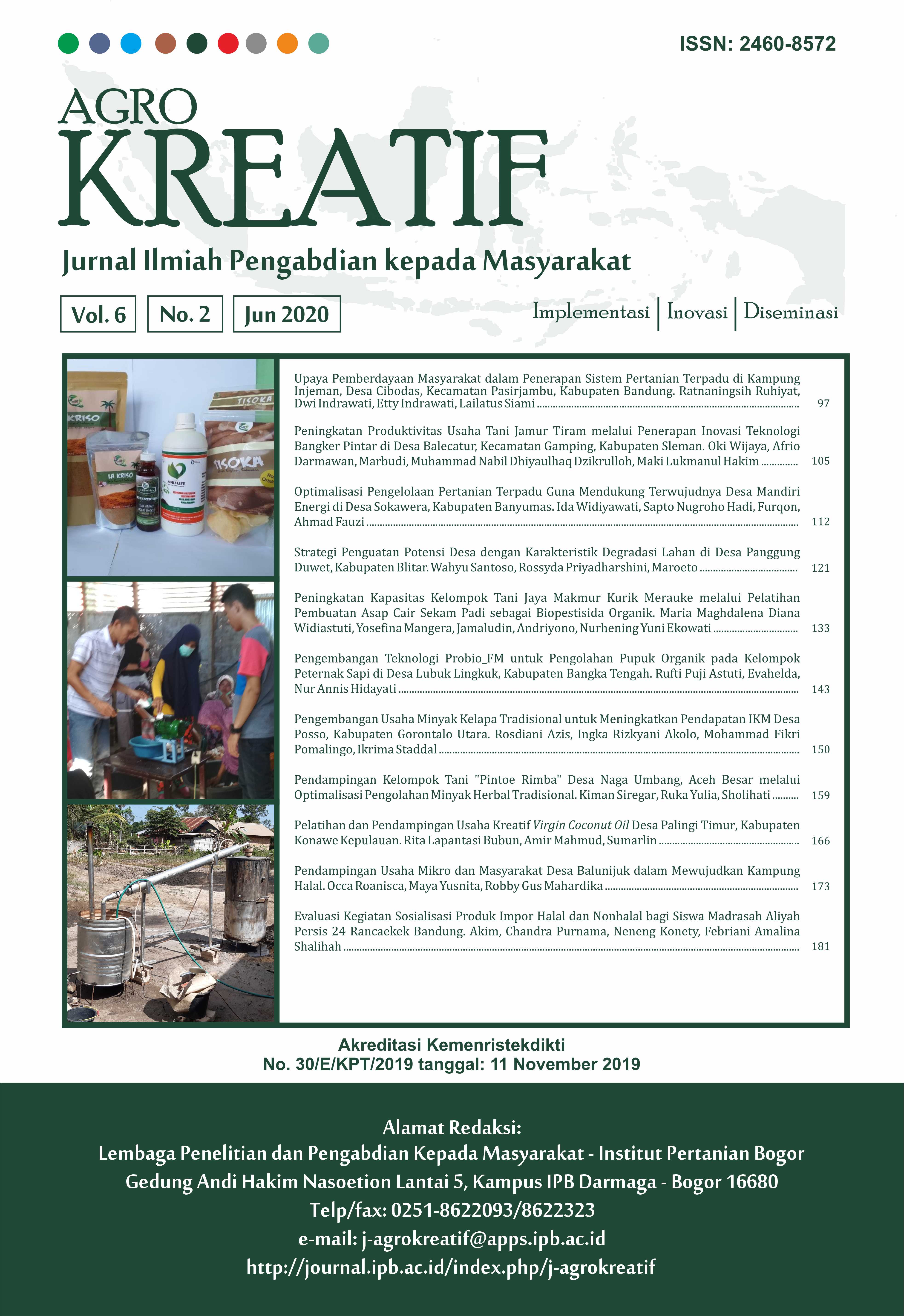Pemberdayaan Masyarakat Melalui Sistem Pertanian Terpadu di Desa Cibodas Kecamatan Pasirjambu, Kabupaten Bandung
Abstract
Integrated farming System (IFS) is a system that combines agricultural activities, farms, and other sciences related to agriculture in one land, so it is expected to be one of the solutions to increase land productivity, and environmental conservation. In implementing the field of IFS implementation to the community, especially farmers and ranchers require guidance and mentoring, so as to perform the IFS run continuously. Empowering the community through Village partnership Development Program (PPDM) aims to improve community empowerment in corn farming, dairy cattle, and make use of waste in Injeman Sub-village, Cibodas Village, Pasirjambu Subistrict, Bandung District. The methods of implementation include counseling, training, focus group discussion, mentoring, as well as the development of land examples IFS. By implementing IFS, then the environment of cow cage becomes cleaner, increased livestock feed from fermented corn waste (silage), the production of organic fertilizer, the existence of renewable energy from cow dung (biogas), and the emergence of Employment from the organic fertilizer business. But in the implementation of the empowerment activities are experienced several obstacles, such as farmers who are not accustomed to use organic fertilizer and ranches who are not accustomed to use silage as livestock feed. Thus it is necessary to mentoring and suppervision both farmers and ranches on the implementation at the following year.
Downloads
References
Arthawidya J, Sutrisno E, Sumiyati S. 2017. Analisis Komposisi Terbaik dari Variasi C/N Rasio Menggunakan Limbah Kulit Buah Pisang, Sayuran dan Kotoran Sapi dengan Parameter C-Organik, N-Total, Phospor, Kalium dan C/N Rasio Menggunakan Metode Vermikomposting. Jurnal Teknik Lingkungan. 6(3). 1‒2
Chen Y, Weinberg ZG. 2009. Changes during aerobic exposure of wheat silages. Animal Feed Science and Technology. 154(1): 76‒82. https://doi.org/10.1016/j.anifeedsci.2009.08.004
Cavaye J. 2015. Understading Community Development: The real voyage of discovery consists not of seeking new landscapes, but in having new eyes. Cavaye Community Development. 1: 1‒19.
Elena M. 2016. Vermicomposting Efficiency and Quality of Vermicompost with Different Bedding Materials and Worm Food Sources as Subtrate. Research Journal of Agriculture and Forestry Sciences. 4(1): 1‒13.
Hariansyah. Pemanfaatan Kotoran Ternak Sapi Sebagai Penghasil Bio Gas. Protech Jurnal Teknik. 8(1): 19‒30.
Hidayat N. 2014. Karakteristik dan Kualitas Silase Rumput Raja menggunakan Berbagai Sumber dan Tingkat Penambahan Karbohidrat Fermentable. Jurnal Agripet. 14(1): 42‒49. https://doi.org/10.17969/agripet.v14i1.1204
Kushartono B, Iriani N. 2005. Silase Tanaman Jagung Sebagai pengembangan Sumber Pakan Ternak. Dalam: Prosiding Temu Teknis Nasional Tenaga Fungsional Pertanian. 2005. Bogor (ID).
Nurcholis M, Supangkat G. 2011. Pengembangan Integrated Farming System untuk Pengendalian Alih Fungsi Lahan Pertanian. Dalam: Prosiding Seminar Nasional Budidaya Pertanian: Urgensi dan Strategi Pengendalian Alih Fungsi Lahan Pertanian. Bengkulu (ID). 7 Juli 2011. ISBN 978-602-19247.
Ruhiyat R, Siami L. 2018. Optimization Biogas Management as Alternative Energy from Communal Scale Dairy Farm. The 4th International Seminar on Sustainable Urban Development. IOP Publishing IOP Conf. Series: Earth and Environmental Science 106 (2018a). https://doi.org/10.1088/1755-1315/106/1/012115.
Ruhiyat R, Indrawati D, Indrawati E, Siami L. 2018. Tinjauan Sosioekonomi Pemanfaatan Feses Sapi dengan Teknoligi Vermikomposting. Journal of Environmental, Engineering and Waste Management. 3(2): 76‒84. https://doi.org/10.33021/jenv. v3i2.463
Theunissen J, Ndakidemi PA, Laubscher CP. 2010. Potential of vermicompost produced from plant waste on the growth and nutrient status in vegetable production (Review). International Journal of the Physical Sciences. 5(13): 1964‒1973.
Wahyuni S. 2015. Panduan Praktis Biogas. Jakarta (ID): Penebar Swadaya.
Weinberg ZG, Muck RE, Weimer PJ, Chen Y, Gamburg M. 2004. Lactic acid bacteria used in inoculants for silage as probiotics for ruminants. Applied Biochemistry and Biotechnology. 18: 1‒9. https://doi.org/ 10.1385/ABAB:118:1-3:001
This work is licensed under a Creative Commons Attribution-NonCommercial 4.0 International License.



















